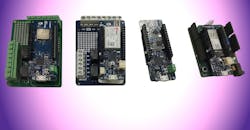Arduino Launches Two New Boards Targeting LoRa, 3G
I missed this year’s Maker Faire in New York City, but just before the show, the CTO of Arduino came to town and talked with Machine Design. Massimo Banzi, co-founder of the Arduino project, is an interaction designer, educator, and open-source hardware advocate. He has worked as a consultant for clients such as Prada, Artemide, Persol, Whirlpool, V&A Museum, and Adidas.
Maker Faire
Massimo started the first FabLab in Italy, which led to the creation of Officine Arduino, a FabLab/Makerspace based in Torino. He spent four years at the Interaction Design Institute Ivrea (IDII) as Associate Professor. Massimo has taught workshops and has been a guest speaker at institutions all over the world.
He currently teaches interaction design at SUPSI Lugano in the south of Switzerland, and is a visiting professor at CIID in Copenhagen, Denmark. Massimo was in town for the New York City Maker Faire, and mentioned that there is a lot of change happening. More and more makers are using the Maker movement to start companies, leading to becoming a corporation.
Interestingly, many of the companies birthed from the Maker Movement will try to hide its origins once a product starts to gain traction. This hasn’t deterred Arduino, though. In fact, they are embracing the move from maker to small business. Massimo wants to help bridge the gap between makers and small companies. He shared two new boards that would launch at the Maker Faire: MKR WAN 1300 (LoRa) and MKR GSM 1400 (3G).
Arduino did this in response to the growth of Industry 4.0, which will only further increase wireless communication. Consequently, you must have access to different technologies for different strategies.
Massimo Banza, Co-Founder and CTO of Arduino
Massimo also pointed out Arduino Create—an online service—offers a web editor, project hub, and cloud service. This will help expedite the process of turning makers into small businesses. However, even if you don’t plan to start a company, Arduino Create is still a handy tool for developing new widgets and devices.
Arduino already offers Wi-Fi and Sigfox shields. Wi-Fi works well for short-range distances that can communicate a lot of data. Sigfox is proficient for longer distances.
In particular, Sigfox is great for long-range narrow-bandwidth applications. The narrow bandwidth limits how much data can be sent, but this helps increase the life of the battery powering it. For remote locations, users may not have a power source and want to limit replacing batteries. This also means the application isn’t time-sensitive.
Continuously sending data takes energy. So to increase battery life, data may only be sent every 10 minutes rather than streaming data in real-time. A drawback with Sigfox is that it doesn’t have very good bidirectional communication. This makes updates and other changes difficult. That issue may be why Arduino released the new LoRa board. It can also cover longer ranges, but offers a wider bandwidth.
Pictured from left to right are Arduino's LoRa board, GSM board, Sigfox board, and Wi-Fi board.
Then taking things to the extreme is the cellular 3G GSM. This board is able to connect directly to the internet and stream data. It can make updates and changes from anywhere in the world. Security is a concern, but depending on what you are protecting, a password and encryption may be enough.
These four wireless options offer different strategies, including the ability to combine them. For example, streaming data on a 3G connection can quickly burn through a battery. One solution is to team up Sigfox and the GSM board. This allows users to collect simple data over time while preserving the battery. Then the GSM shield can be used for short periods to send updates, or changes.
Before Massimo left, he said he did this to help his students; he had no idea that it would go this far. Even so, he is still concerned with education. Arduino offers a box or kit with an online forum for help, all aimed toward students 13 to 17 years old. If you want to hear more about the current state of Arduino, check out Massimo’s speech at Maker Faire NYC:




